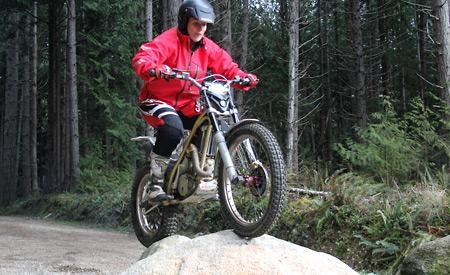VIDEO – Heather Wall often seems to be defying gravity, or at the very least common sense, as she rides a small, seatless dirt bike over rocks and up embankments, showing off her skills in a sport popular in Europe but almost unheard of here: trial riding.
Riding a light-weight, off-road bike, Wall demonstrates some of the skills required to be a trial rider. She bounces up and off rocks and rides up and down vertical embankments with ease using a two-tap accelerating tactic and balance that seems nearly impossible. The rain has prevented a trip to the big rocks Wall tells of, but even this miniature version of the event is enough to show the skill and patience that must go into it.
Trial riding enjoys a large following in Europe, especially in the United Kingdom and Spain and, unlike its cousin motocross, has never really taken off in this part of the world. Trial events take place on a looped cross-country course where riders have to negotiate 10 to 15 preset sections with boulders, logs or other natural obstacles. Trial riding is scored on a point system where the lowest score wins and every time a rider puts their foot on the ground they’re given points.
Trial riding is the oldest competitive motorcycle sport. One event in the United Kingdom is celebrating its 100-year anniversary. Wall guesses it probably started with “guys being guys,” challenging each other to ride over increasingly difficult obstacles without touching the ground.
Growing up in Calgary, Wall started riding trial bikes at eight years old, following in the footsteps of her father and two brothers. She could barely touch the ground as she rode through fields on her father’s 250cc bike, a large bike for a child. She competed throughout high school but put it aside when she went to college and needed to sell her bike to help pay for tuition. She returned to the sport and started competing again around 2003.
“It’s the space between your ears,” said Wall on her love of the sport. “The urge to put your foot down is sometimes really great so you have to have a level of concentration to challenge yourself through a section. I think that’s what I like about it the most, it’s a big self challenge.”
Wall’s trial bike weighs 145 pounds and is made by Gas Gas, a company based out of Spain. Gears on the bike are specifically designed for climbing items, meaning that the first four gears are calibrated to be fairly slow to give the rider more control over speed. Wall said a cross-country dirt bike’s first gear will be like her third gear. However, this hasn’t stopped her from beating cross-country riders in scramble races while on a trial bike.
At events in the USA, Spain, Italy, France, Andorra and across Canada, Wall has proven herself to be among the world’s elite female riders. Wall consistently came in the top 30 in the world, which she said may not sound hugely impressive, but isn’t bad considering that the top 10 riders at least are fully sponsored by bike companies and ride full time. To do all this after going to college, having a child, following a career and taking years off from competing only adds to her achievements.
The sport’s governing body, the Fédération Internationale de Motocyclisme (FIM), is trying to promote the sport more to women, said Wall, but it’s a slow go around here. Women are still the minority when it comes to trial riding. Wall said she was the only female competitor in Alberta, although there are at least six or seven women riders in BC. Following her father and brothers around constantly helped Wall break into the sport. She still rides events in men’s fields, especially in Canada.
Last year Wall moved from Calgary to Powell River and believes she’s now in trial-riding paradise. Staying on top of her sport while having to pack away her bike for a good four or five months every year because of the weather is a challenge. Trial riders from the West Coast tend to be better because they can train all year and can be constantly improving rather than recapping every spring. Learning to ride in wet, slippery conditions can also be an advantage because once you have that mastered dry riding is a cinch.
“It’s like Shangri-La here,” said Wall. “I just can’t get over the green grass in February. It just seems so wrong on so many levels.”
Already with some choice spots picked out, barring being rained out, Wall is having fun riding every chance she has and, to her shock and delight, in winter no less. There’s a small group of local trial riders in town Wall has run into and enjoys talking with. She thinks her days of heading off to international events are most likely behind her, although as recently as last year she has been taking part in events in western Canada. But for now, she’s glad to be able to play right in her backyard and whenever she wants.



